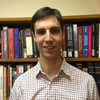As a Jesuit and future Catholic priest in Fordham University’s Theology Ph.D. program, I began teaching one of the introductory courses in theology, “Faith and Critical Reason”, a requirement for all undergraduates. I am open with my students about my Jesuit, Catholic identity, and I most often (but not always) wear clerics while I teach. I consider teaching not only an academic exercise but also a vocational calling. This self-understanding may cause some people to worry that the profession of an academic might conflict with that of a clergy member. Some may wonder, “Can a religious leader of a particular community be impartial so that all can freely share their ideas?”
Opening Diverse Pathways
When I sat down to construct the syllabus for this course, I was concerned that my own religious perspective might unintentionally lead to my assigning readings and giving lectures that are not diverse enough to make at least some material relatable to all students. I wanted to provide them with a broad swath of readings that addressed topics from a variety of perspectives and were relevant to their experiences. I wondered, “How can I engage every student in my class so as to provide a pathway into the material from where each stands with regard to faith?”
Of course, I knew that some would likely not identify themselves as “having faith” in the traditional sense of associating with a particular faith tradition or believing in God. Nevertheless, I wanted to make faith relevant to those students as well. I developed a set of criteria that would help me to diversify my syllabus, aiming to provide the students with material that was: multireligious, classic and contemporary, traditional and “progressive,” religious and non-religious. I think that this approach is a salient feature of the course. In the anonymous evaluation for the course in which students gave their feedback, about one-quarter commented specifically on the diversity of readings assigned when asked to name what they thought were positive aspects of the course.
I think that this diversity opens paths for critical thinking in which different perspectives can be brought into dialogue. One semester I recall that a student, we will call him “John”, expressed early on in the course that he was not particularly religious. During one class, he made a comment in which he passionately stated the philosophical argument for the existence of God being presented was completely bogus. My approach to his opinion was to incorporate it into the discussion to allow him and the class to further scrutinize the argument for the existence of God at a more fundamental level, which is what I thought John was signaling with his comments.
Prior to going over this argument, I had assigned an excerpt from Sigmund Freud. In it, he expresses that the belief that there is a God comes from a person’s attempt at fulfilling their desires by falsely fabricating this belief in her/his mind. Therefore, God is not real but merely a projection of the person’s mind. I think that the diversity of perspectives represented on the syllabus – such as that of Freud’s in contrast to arguments for the existence of God that are standard in theology – encourages opinions like those of John to be voiced. At the same time, diversity on the syllabus is not only intended to bring out various perspectives, but also to bring about dialogue among these perspectives. I think that it is very significant that after John offered comments in class, he subsequently came to office hours on three different occasions throughout the semester, none of which were required, to discuss various questions about God and religiosity.
Offering a Witness
Despite this approach, the course inevitably reflects my faith and the interests that come with it. Yet, I think that this effort to reach students and provide ways for them to access course topics combined with my own faith is itself a type of “witness” to students. It is not a witness by way of an explicit statement of my faith. Rather, it is one in which my presentation of various topics communicates what I take to be important faith-considerations. My own faith undoubtedly comes through in my handling of the whole process of delivering the material for the class and engaging with students on it, even though I never invoke my faith explicitly. In my view, by approaching the course in this way, I have not set up any barriers to the free exchange of ideas in the classroom, at least not more than any other professor.
I would argue that the question of how clergy members respect the free exchange of ideas in their role as university professors is part of a much larger question regarding how all professors approach their teaching. All professors come from and have been formed in particular contexts. They have religious, cultural, social, political backgrounds that inform the material that they present and the way that they present it. Of course, this does not apply to the content of, for example, math courses, but it certainly applies to history, philosophy, anthropology, and many other subjects. No one is a neutrally positioned person in a university classroom. One’s background and current social context is a permanent influence on a person’s identity that affects the selection and presentation of course materials.
At the same time, once someone owns this part of their identity and the knowledge that aspects of it are inevitably enduring, there is an equal responsibility to consistently strive to open a space in which all can express their opinions and have access to views that would support those opinions (though all hate-speech should be excluded). While providing this variety of views, students should be encouraged to search for the “truth” regardless of the views of the professor.
Clerical Responsibilities
Still, this vision of the role of a university professor, when applied to a cleric, takes on a specific character. Not only does a member of the clergy have religious commitments, but s/he is also an official representative of a believing community – and, in Christianity, likely ordained.
On one level, any religiously affiliated person would share with a cleric the unique aspect of being a teacher of something that intimately touches one’s identity. Teaching theology is not like teaching history: however much one might be passionate about this discipline or its content, history does not necessarily involve one’s very identity in the same personal way that theology and religion does. Theological views are tied up with one’s affections, relationships (for example, one’s network of family and friends), moral compass, and other integral aspects of the person. It might be tempting for a religiously affiliated professor of theology to neglect the aim of facilitating the free exchange of ideas in the classroom in order to protect these intimately held convictions.
On another level, a member of the clergy has the additional responsibility of being an ordained member of a particular religion, and so is a representative of that religion. This often includes people who have authority over that person (such as a bishop or religious superior) that shape a cleric’s views and govern him/her in some ways. These aspects of a cleric-professor can result in an additional temptation to limit the presentation of theological views so as to be more in line with the views of the religion to which the s/he belongs.
On both levels, however, the combination of maintaining a commitment to the free exchange of ideas and to a particular religion actually lends increased credibility to the faith believed – precisely because faith is intimately integrated into the professor’s life. But if a religiously affiliated professor leverages his/her position to intentionally present a narrow view on a particular religious topic, this detracts from his/her credibility. Instead, if the professor holds his/her faith sincerely without attempting to limit others within those bounds, this allows students the freedom to experience that same faith (the professor’s) in their own way. This happens through their engagement both with course materials and the professor, who selects and organizes materials and actively engages and responds to students on these materials.
Invitation to Understanding
Besides the fact that it is impossible to be neutral, being open about one’s religious commitments may actually help others understand their own, whether they are the same or different from the professor’s. An educator who can model what it looks like to hold a position in a way that leaves space for the perspectives of others, and who remains genuinely open to those views, will form students in a far better way than a professor who falsely presents him/herself as “neutral” while “smuggling” in her/his own views, intentionally or not. A professor whose religious identity and basic stance is manifest, openly models the human person as s/he is, limited and yet striving for a more multifaceted and more universal understanding.
Students very often demonstrate this ability to own their view while remaining open to new ideas/experiences In one of the course assignments: the “spiritual autobiography.” In it, students explore the history of spiritual/religious influences on them and how it impacts their identity. Some students express being deeply rooted in a particular religious tradition. Others relate snippets of these influences on their life even while they did not have the experience of growing-up belonging to a religious community. Nevertheless, all have had some interaction with religion/spirituality and so have the occasion to reflect on their own identities with respect to it. Frequently, students say that they have some kind of religious/spiritual commitments to, for example, belief that there is a God. At the same time, they often realize that these beliefs can grow, contract, or develop. The spiritual autobiography gives them the opportunity to express their identity with respect to spirituality/religion in a way that is complex and open to further understanding. This identity can be thought of as something that is already established even while it is open to encountering new ideas/experiences that could cause a shift in it.
Turning back to the religious identity of the professor, we might ask: If a cleric believes that this profession as an educator is a vocation, and therefore a calling from God (as complex as such a belief might be), then it would seem odd to intentionally mask a religious allegiance, especially since the biases that are the result of any allegiance (religious or otherwise) inevitably comes through in one way or another.
In considering my own identity, I find myself asking: If the experience of having a vocational calling to be a university educator is indeed just that, why would I try to disown the very source that brought me to these students in the first place? And if a professor’s honesty about religious allegiance, modeling of commitment, and openness to new perspectives can facilitate the free exchange of ideas while allowing students to better understand their identities, then this seems to me to be a wise way of proceeding.
-//-
Photo by Aaron Burden on Unsplash.


